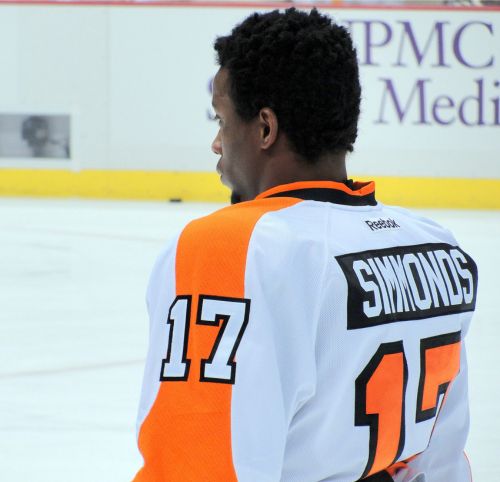One of professional hockey’s most accomplished Black players hangs up his skates.
It is very hard to grasp that after playing in over 1,000 National Hockey League regular-season games and notching 526 career points in 15 seasons, Wayne “The Train” Simmonds recently announced his retirement.
Simmonds, regarded as one of the most prominent and revered Black NHL hockey players of all time, is hanging up his skates.
The North American Black hockey community has widely admired his career because, in a sport where there haven’t been many examples of Black excellence, Simmonds personified that and more — a Black hockey player who shined at the absolute pinnacle of his sport.
Black players like Simmonds give millions of hockey youth hope that they can play professionally in the NHL or at least in what most hockey enthusiasts call “The Show.”
This is a guy who undoubtedly played the game the righteous way and never cheated anyone, not even hockey fans. This was the man who became a one-time all-star and won the 2017 NHL All-Star Game’s Most Valuable Player award — the second Black player to do so since Grant Fuhr in 1986. If there’s one former millennial NHLer who deserves to win Lord’s Stanley Cup, it’s Wayne Simmonds.
He is the same man who scored a hat trick — three goals in a hockey game — against the New York Rangers in Game 6 of the first round of the 2014 Stanley Cup Playoffs to help his team avoid elimination. Simmonds was the man who represented his home country of Canada on three different occasions, which resulted in a gold medal at the 2008 World Junior Championships and a silver medal in the 2017 Mens’ World Championship. Indeed, this is the same man who won the prestigious Mark Messier Leadership Award for being a role model in and outside of the sport of hockey.
I am deeply crestfallen to learn that this same figure who played with such potency and intensity on every shift as if it were his last is leaving our game. This is the exact player who scored more than 30 goals and recorded over 100 minutes in penalties in two straight 80-plus game seasons, conveying a physical and scoring presence on the ice every game.
This Toronto native’s style of play was the epitome of a true power forward — a physical, offensively talented and productive player. His goals might not have been as flashy and pretty as those of other stars like Sidney Crosby, Alex Ovechkin, or Connor McDavid. Still, millions of fans, Black and White, acknowledged his hustle and determination.
According to “Soul On Ice, Past, Present, and Future” film director Damon Kwame Mason,
“There is a kid out there watching who looks like Wayne Simmonds that jumped for joy because Wayne is his favorite player, and seeing him, made him feel he could do it as well,” Mason told B/R. “There is a kid that watched that doesn’t look like Wayne, but he is also his favorite player, and seeing Wayne confirmed to him that there is no difference. They are just hockey players.”
Despite having a 6-foot-2 inch, 183-pound frame, he was the authentic embodiment of a grinder who fought like a ferocious warrior. His 1,313 penalty minutes were a perfect testament to how competitively driven he was as a player for the Los Angeles Kings, Philadelphia Flyers, Nashville Predators, Buffalo Sabres, New Jersey Devils and the Toronto Maple Leafs.

Even former NHL All-Star P.K. Subban, another prolific Black hockey great, knew the raw Canadian grit and potent fighting ability that Simmonds brought to every tilt. Subban’s former teammate and fellow NHL All-Star Max Pacioretty asked Subban if Simmonds would be a great match for him in a fight. Subban replied, “No, you cannot fight Wayne Simmonds.”
Not many people, especially hockey fans, can fully understand what Simmonds endured throughout his childhood in Toronto’s Scarborough neighborhood. During the summers, he sold boxes of chocolates to afford his clothes.
When he was a third grader, his teacher asked him what career he wanted to choose as an adult. Without hesitation, he said an NHL player. The teacher forced him to change his answer, but Simmonds refused. Instead, the teacher called his parents to force him to write a report on another career path that was appropriate.
He wrote about pursuing aspirations as an NHL athlete against his teacher’s orders.
Like all hockey parents, Cyril and Wanda Simmonds have made many sacrifices for their son to play for numerous amateur teams in the Toronto hockey scene, which honed incredible talent. One of his childhood coaches, Michael Hutton, was a tremendous help to him and his family by covering expenses for trips to games and tournaments.
Like every Black player in this world, Simmonds was no stranger to being racially victimized by rabble-rousers throughout his entire career. There was one despicable instance that was probably the worst act of racism in his career. During a Sept. 22, 2011, pre-season game against the Detroit Red Wings in London, Ontario (a two-hour drive South from his hometown of Scarborough), Simmonds, who played for the Philadelphia Flyers back then, participated in a shootout.
When he skated several inches close to the Red Wings goaltender, a White 26-year-old fan named Christopher Moorhouse threw a banana in Simmonds’s direction. However, he still managed to score. Moorhouse later pleaded guilty to engaging in a prohibited activity and was forced to pay a $200 fine. He didn’t even appear in court.
Simmonds experienced another hateful gesture of racism as a player for ETC Crimmitschau, a professional team based in Germany. He played for them due to the 2012-13 NHL lockout. During a game against Pirati Chomutov in the Czech Republic, fans jeered at him by chatting “opice,” which means “monkey” in their native language. As a brilliant role model with incredible class, Simmonds refused to let those atrocious brutalities affect his stature as a fabled player in the NHL and the world.
This gladiator, who idolized Hall of Famer and former all-star Sergei Fedorov and even wore his jersey number “91” as a youth, has been through the highs and lows of a remarkable career that began at age five and ended at 35.
Simmonds is now in the same category as former illustrious Black NHLers such as Anson Carter, Mike Grier, Dustin Byfuglien, Sugar Ray Emery, Joel Ward, Tony McKegney, Dirk Graham, the great Jarome Iginla, and Fuhr and Subban. With a gracious demeanor, he even launched a nonprofit dubbed “Wayne’s Road Hockey Warriors” during his time in the NHL to raise and cover hockey expenses for underserved kids in Scarborough.
Hopefully, in the future, this man who is known as “The Train” will make his last stop at the Hockey Hall of Fame.

